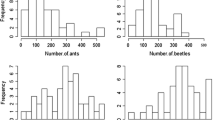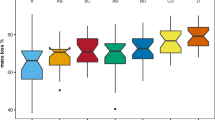Abstract
The purpose of this study was to relate regional variation in litter mass-loss rates (first year) in pine forests to climate across a large, continental-scale area. The variation in mass-loss rate was analyzed using 39 experimental sites spanning climatic regions from the subarctic to subtropical and Mediterranean: the latitudinal gradient ranged from 31 °N to 70 °N and may represent the the largest geographical area that has ever been sampled and observed for the purpose of studying biogeochemical processes. Because of unified site design and uniform laboratory procedures, data from all sites were directly comparable and permitted a determination of the relative influence of climateversus substrate quality viewed from the perspective of broad regional scales.
Simple correlation applied to the entire data set indicated that annual actual evapotranspiration (AET) should be the leading climatic constraint on mass-loss rates (Radj 2 = 0.496). The combination of AET, average July temp. and average annual temp. could explain about 70% of the sites' variability on litter mass-loss. In an analysis of 23 Scots pine sites north of the Alps and Carpatians AET alone could account for about 65% of the variation and the addition of a substrate-quality variable was sufficiently significant to be used in a model.
The influence of litter quality was introduced into a model, using data from 11 sites at which litter of different quality had been incubated. These sites are found in Germany, the Netherlands, Sweden and Finland. At any one site most ( ≫ 90%) of the variation in mass-loss rates could be explained by one of the litter-quality variables giving concentration of nitrogen, phosphorus or water solubles. However, even when these models included nitrogen or phosphorus even small changes in potential evapotranspiration resulted in large changes in early-phase decay rates.
Further regional subdivision of the data set, resulted in a range of strength in the relationship between loss rate and climatic variables, from very weak in Central Europe to strong for the Scandinavian and Atlantic coast sites (Radj 2 = 0.912; AETversus litter mass loss). Much of the variation in observed loss rates could be related to continentalversus marine/Atlantic influences. Inland locations had mass-loss rates lower than should be expected on the basis of for example AET alone. Attempts to include seasonality variables were not successful. It is clear that either unknown errors and biases, or, unknown variables are causing these regional differences in response to climatic variables. Nevertheless these results show the powerful influence of climate as a control of the broad-scale geography of mass-loss rates and substrate quality at the stand level.
Some of these relationships between mass-loss rate and climatic variables are among the highest ever reported, probably because of the care taken to select uniform sites and experimental methods. This suggest that superior, base line maps of predicted mass-loss rates could be produced using climatic data. These models should be useful to predict the changing equilibrium litter dynamics resulting from climatic change.
Similar content being viewed by others
References
Aber JD & Melillo JM (1982) Nitrogen immoblization in decaying hard-wood leaf litter as a function of initial nitrogen and lignin content. Canadian Journal of Botany 60: 2263–2269
Axelsson B & Br»kenhielm S (1980) Investigation sites of the Swedish Coniferous Forest Project. Biological and physiographical features. Ecological Bulletins (Stockholm) 32: 25–64
B»»th E, Berg B, Lohm U, Lundgren B, Lundkvist H, Rosswall T, Söderström B & Wiren A (1980) Effects of experimental acidification and liming on soil organisms and decomposition in a Scots pine forest. Pedobiologia 20: 85–100
Berg B (1990) Measurements of litter decomposition rates in two forest research plots with monocultures of Norway spruce (Degeberga) and Scots pine (Granö). Swedish University of Agricultural Sciences. Department of Ecology and Environmental Research. Soil Organic Matter Turnover, Report, 16 pp
Berg B (1986) Nutrient release from litter and humus in coniferous forest soils — a mini review. Scandinavian Journal of Forest Research 1: 359–370
Berg B & Staaf H (1980) Decomposition rate and chemical changes of Scots pine needle litter. II Influence of chemical composition. Ecological Bulletins (Stockholm) 32: 363–372
Berg B, Staaf H & Wessén B (1987) Decomposition and nutrient release from nitrogen — fertilized Scot pine stands. Scandinavian Journal of Forest Research 2: 399–415
Berg B & Lundmark JE (1987) Decomposition of needle litter in lodgepole pine and Scots pine monocultures — a comparison. Scandinavian Journal of Forest Research 2: 3–12
Berg B & Ekbohm G (1991) Litter mass loss rates and decomposition patterns in some needle and leaf litter types. Long-term decomposition in a Scots pine forest VII. Canadian Journal of Botany 69: 1449–1456
Berg B, Hannus K, Popoff T & Theander O (1982) Changes in organic chemical components of needle litter during decomposition. Long-term decomposition in a Scots pine forest I. Canadian Journal of Botany 60: 1310–1319
Berg B, Booltink HGW, Breymeyer A, Ewertsson A, Gallardo A, Holm B, Johansson MB, Koivuoja S, Meentemeyer V, Nyman P, Olofsson J, Pettersson A, Reurslag A, Staaf H, Staaf I & Uba L (1991) Data on needle litter decomposition and soil climate as well as site characteristics. Swedish University of Agricultural Sciences. Department of Ecology and Environmental Research. Report No. 41
Berg B, Berg M, Bottner P, Box E, Breymeyer A, Calvo de Anta R, Couteaux M, Gallardo A, Escudero A, Kratz W, Maderia M, Meentemeyer V, Muñoz F, Piussi P, Remacle J & Virzo De Santo A (in press) Litter mass loss in pine forests of Europe: relationships with climate and litter quality. In: Breymeyer A (Ed) Proceedings from Scope Seminar. Geography of Carbon Budget Processes in Terrestrial Ecosystems. Szymbark, Aug. 17–23, 1991
Bethge PO, R»deström R & Theander O (1971) Kvantitativ kolhydratbestämning — en detaljstudie. Communication from Swedish Forest Production Research Lab. 63B. S-114 86 Stockholm. (In Swedish)
Dyer ML (1986) A model of organic decomposition rates based on climate and litter properties. M.A. Thesis, University of Georgia, Athens, GA
Dyer ML, Meentemeyer V & Berg B (1990) Apparent controls of mass loss rate of leaf litter on a regional scale. Scandinavian Journal of Forest Research 5: 311–323
Ekbohm G & Rydin B (1990) On estimating the species-area relationship. Oikos 57: 145–146
Fogel R & Cromack K (1977) Effects of habitat and substrate quality on Douglas fir litter decomposition in western Oregon. Canadian Journal of Botany 55: 1632–1640
Johansson MB (1986) Chemical composition and decomposition of leaf litter from forest trees in Sweden with special reference to methodological aspects and site properties. Reports in Forest Ecology and Forest Soils, No. 56. Department of Forest Soils. Swedish University of Agricultural Sciences, Uppsala
Lousier JD & Parkinson D (1976) Litter decomposition in a cool temperature deciduous forest. Canadian Journal of Botany 54: 419–436
McClaugherty C & Berg B (1987) Cellulose, lignin and nitrogen levels as rate regulating factors in late stages of forest litter decomposition. Pedobiologia 30: 101–112
McClaugherty CA, Pastor J, Aber JD & Melillo JM (1985) Forest litter decomposition in relation to soil nitrogen dynamics and litter quality. Ecology 66: 266–275
Meentemeyer V (1978) Macroclimate and lignin control of litter decomposition rates. Ecology 59: 465–472
Meentemeyer V (1984) The geography of organic decomposition rates. Annals of the Association of American Geographers 74: 551–560
Meentemeyer V & Berg B (1986) Regional variation in mass-loss ofPinus sylvestris needle litter in Swedish pine forests as influenced by climate and litter quality. Scandinavian Journal of Forest Research 1: 167–180
Minderman G (1968) Addition, decomposition and accumulation of organic matter in the soil. Journal of Ecology 56: 355–362
Rogers SN (1986) A comparison of in-situversus litterbag estimates of litter decomposition rates and their relationships with climate. M.A. Thesis, University of Georgia, Athens, GA
Sharpe DM & Prowse CW (1983) WATERBUD: Water budget concepts and applications. Environmental Simulations Laboratory, Carbondale, IL, USA
Tamm CO, Nilsson Å & Wiklander G (1974) The optimum nutrition experiment Lisselbo. A brief description of an experiment in a young stand of Scots pine (Pinus silvestris L.). Departments of Forest Ecology and Forest Soils, Royal College of Forestry, Stockholm, Research Notes 18, 25 pp
Tenney FG & Waksman SA (1929) Composition of natural organic materials and their decomposition in the soil: IV The nature and rapidity of decomposition of the various organic complexes in different plant materials, under aerobic conditions. Soil Science 28: 55–84
Thornthwaite CW & Mather JR (1957) Instructions and tables for computing potential evapotranspiration and the water balance. Publications in Climatology 10: 185–311
Upadhyay VP & Singh JS (1985) Nitrogen dynamics of decomposing hardwood leaf litter in a Central Himalayan forest. Soil Biology and Biochemistry 17: 827–830
Willmott CJ, Mather JR & Rowe CM (1981a) Average monthly and annual surface air temperature and precipitation data for the world. Part I The eastern hemisphere. Publications in Climatology, Vol. 34, No. 1
Willmott CJ, Mather JR & Rowe CM (1981b) Average monthly and annual surface air temperature and precipitation data for the world. Part II The western hemisphere. Publications in Climatology, Vol. 34, No. 2
Virzo De Santo A, Berg B, Rutigliano FA, Alfani A & Fioretto A (in press) Factors regulating early-stage decomposition of needle litter in five different coniferous forests. Soil Biology and Biochemistry
Witkamp M & Olson JS (1963) Breakdown of confined and non-confined oak litter. Oikos 14: 138–147
Author information
Authors and Affiliations
Rights and permissions
About this article
Cite this article
Berg, B., Berg, M.P., Bottner, P. et al. Litter mass loss rates in pine forests of Europe and Eastern United States: some relationships with climate and litter quality. Biogeochemistry 20, 127–159 (1993). https://doi.org/10.1007/BF00000785
Received:
Accepted:
Issue Date:
DOI: https://doi.org/10.1007/BF00000785




